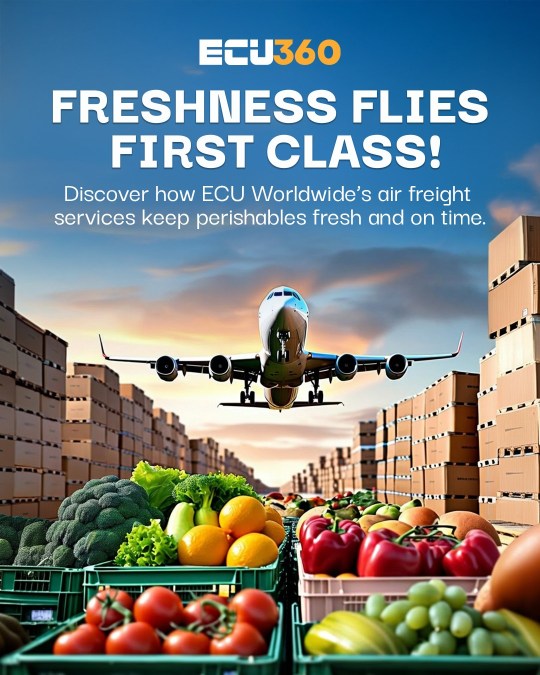#PerishableGoods
Explore tagged Tumblr posts
Text
The Sydney Business Owner's Essential Guide to Refrigerated Transport

Running a business in Sydney that relies on temperature-sensitive goods? Don't risk spoiled products! Our latest blog post is your comprehensive guide to choosing trusted refrigerated transport and logistics providers. Learn about technology, compliance, pricing, and more! Read more
#SydneyEntrepreneurs#BusinessGrowth#ColdChainLogistics#refrigeratedtransport#dardanialogistics#perishablegoods#temperaturecontrolled#sydneylogistics
0 notes
Text

Freshness Flies First Class! At ECU Worldwide, we specialize in air freight services for perishable goods. Our state-of-the-art technology and expertise ensure your products stay fresh and arrive on time.
To know more, visit - https://ecu360.com/
#ECU360#ECUWorldwide#AirFreight#PerishableGoods#FreshnessDelivered#ColdChainLogistics#SupplyChainSolutions#GlobalShipping#FreightForwarding#SeamlessLogistic
0 notes
Text
Market Dynamics of Cold Chain: Analyzing Current Size, Share, Growth Trends
The cold chain market is driven by the stringent government regulations imposed on production and supply chains, owing to the increasing number of food safety and pharma counterfeit incidents. Governments, across the globe, have stated various regulations and guidelines for storage and transportation of refrigerated products. For instance, in November 2013, the European Union passed guidelines on good distribution practices for medical products used on humans.

To ensure safety and quality of the food products the service providers are engaged in vertical integration with the customers. The lack of cold chain facilities in developing economies leads retailers to heavily invest in developing their own cold chain logistics systems.
Global Cold Chain Alliance (GCCA), a non-profit organization headquartered in the U.S., is a platform that enables networking, communication, and education in all the sectors of a cold chain. The core partners of GCCA include International Association of Refrigerated Warehouse, International Association of Cold Storage Construction, and International Refrigerated Transportation Association.
Companies utilize cold chain services to minimize supply chain risks. The advent of cloud technology is expected to spur the IT spending over the projected period. Additionally, the cloud solution reduces the total cost of ownership and improves the logistics performances.
According, to the Food and Agriculture Organization (FAO), annually 1.6 billion tons of food products are wasted, owing to the lack of adequate temperature management systems. To overcome such problems organizations have increased their spending on technologies such as smart refrigerator systems and cloud computing solutions which increased the demand for the monitoring components market.
The increasing need for enhanced connectivity and emergence of IoT solutions is anticipated to further increase the IT spending on cold chain. An organization implementing IT solutions is mandated to adhere to the IT security guidelines of the National Institute of Standards and Technology and other regulations framed by government organizations including the U.S. Food and Drug Administration, WHO, and the EU regulation for food and drug safety. The growing installation of sensors and smart connected devices in refrigerated containers provides real-time information. The key vendors of the market include Accenture PLC (U.S.), AT&T, Inc. (U.S.), Cisco Systems, Inc. (U.S.), and Oracle Corporation (U.S.).
Government across regions are taking initiatives to attract the investment in cold chain infrastructure. For instance, the Indian Ministry of food processing industries implemented central sector scheme of cold chain. The scheme provides financial assistance for setting up the integrated cold chain infrastructure to avoid post-harvest losses.
The adoption telematics system would help the companies to reduce the fuel expenses and number of empty of runs. Increasing government investments in intelligent transportation system and implementing telematics regulations to enable smart traffic management is anticipated to spur the telematics application in fleet management.
North American region is showing highest penetration growth in the cold chain market owing to the prevailing large consumer based and increasing penetration of connected devices are the major factors driving the North American regional market. The industry players are likely to target the emerging economies such as India, Brazil owing to the government initiatives such as digital India, introduction of GST.
#ColdChain#ColdChainLogistics#SupplyChain#TemperatureControlledLogistics#Logistics#PerishableGoods#RefrigeratedTransport
0 notes
Text
Cold Chain Packaging Market Innovations Shaping the Future of Temperature Controlled Logistics
The cold chain packaging market is a critical segment of the global supply chain ecosystem, playing an essential role in maintaining the quality and safety of temperature-sensitive products. This market encompasses the packaging materials and technologies used to preserve goods at controlled temperatures throughout storage and transportation. With the rising demand for pharmaceuticals, perishable food products, and biologics, the cold chain packaging market has witnessed significant growth, driven by technological innovations and stricter regulatory frameworks.

Overview of Cold Chain Packaging
Cold chain packaging involves specialized containers, insulated boxes, refrigerants, and temperature monitoring devices that help maintain specific temperature ranges required for sensitive products. These products include vaccines, blood samples, fresh fruits and vegetables, dairy products, seafood, and certain chemicals that degrade if exposed to temperature fluctuations.
The importance of cold chain packaging became particularly evident during the COVID-19 pandemic when vaccines requiring ultra-low temperatures were distributed globally. This event highlighted the need for reliable packaging solutions capable of maintaining temperatures as low as -70°C, emphasizing the market’s growth potential and innovation opportunities.
Market Drivers
Several factors are propelling the growth of the cold chain packaging market:
Rising Demand for Pharmaceuticals and Biologics: The pharmaceutical industry, especially biologics and vaccines, requires stringent temperature control to ensure product efficacy and safety. With the increase in chronic diseases and the development of personalized medicine, the need for cold chain packaging has surged.
Growth in Perishable Food Industry: Increasing consumer preference for fresh and organic food has led to a rise in cold storage and transportation requirements. The expansion of e-commerce and online grocery delivery services also fuels demand for reliable cold chain solutions.
Stringent Regulatory Standards: Governments and international bodies have implemented strict regulations around the handling and transportation of temperature-sensitive products. Compliance with these regulations necessitates the use of advanced packaging technologies, further driving market growth.
Technological Advancements: Innovations such as phase change materials (PCMs), vacuum insulated panels (VIPs), smart packaging with IoT-enabled temperature sensors, and eco-friendly insulation materials are revolutionizing cold chain packaging, making it more efficient and sustainable.
Market Challenges
Despite strong growth prospects, the market faces certain challenges:
High Costs: Advanced cold chain packaging solutions can be expensive, limiting adoption, especially in developing regions.
Logistical Complexities: Maintaining an unbroken cold chain across long distances, especially in countries with poor infrastructure, is challenging.
Environmental Concerns: Many cold chain packaging materials are non-biodegradable, raising sustainability issues.
Key Market Segments
The cold chain packaging market is segmented based on material type, application, end-user, and region:
Material Type: Includes insulated containers, gel packs, dry ice, phase change materials, and refrigerants.
Application: Pharmaceuticals, food and beverages, chemicals, and others.
End-User: Hospitals and clinics, food distributors, research laboratories, and logistics companies.
Region: North America, Europe, Asia Pacific, Latin America, and Middle East & Africa.
Among these, the pharmaceutical segment is one of the fastest-growing due to the increasing need for vaccines and biologics. Asia Pacific is expected to witness rapid growth driven by expanding healthcare infrastructure and rising demand for fresh food products.
Future Trends and Opportunities
The future of the cold chain packaging market looks promising with several emerging trends:
Sustainable Packaging Solutions: Growing environmental awareness is pushing manufacturers to develop biodegradable and recyclable cold chain packaging materials.
Digital Integration: The integration of IoT and blockchain technology in cold chain packaging enhances real-time temperature monitoring and traceability, improving transparency and reducing product loss.
Customized Solutions: Demand for tailor-made packaging solutions that cater to specific temperature ranges and product types is increasing.
Expansion in Emerging Markets: Increasing healthcare spending and food consumption in regions like Asia, Latin America, and Africa present vast opportunities for market players.
Conclusion
The cold chain packaging market is at a pivotal stage of growth, driven by increasing demand for temperature-sensitive pharmaceuticals and perishable food products. Technological innovations and rising regulatory standards are shaping the market’s trajectory, pushing for more efficient, sustainable, and smarter packaging solutions. While challenges such as cost and logistics remain, the opportunities offered by digital integration and expanding markets make cold chain packaging an exciting and dynamic industry to watch in the coming years.
#ColdChainPackaging#ColdChainMarket#TemperatureControlledLogistics#PharmaceuticalPackaging#PerishableGoods#SupplyChainInnovation
0 notes
Text

Tzone Single Use Temperature Data Logger TempU09 A Single Use Temperature Data Logger is a compact, pre-configured device designed to record temperature data during a single shipment or monitoring cycle. Once used, it typically cannot be reused. These are commonly used in cold chain logistics, especially for pharmaceuticals, vaccines, food, and perishable goods. Buy ; https://vegabazaar.com/product/best-tzone-single-use-temperature-data-logger-tempu09/ ureSensor
#temperaturelogger#singleusedatalogger#ColdChainMonitoring#TemperatureMonitoring#datalogger#pharmalogistics#usbdatalogger#pdfdatalogger#coldchainlogistics#ColdStorage#vaccinetemperaturelogger#perishablegoods#TemperatureSensor
0 notes
Text

🔹 Smart Cold Storage Management with @omexcsms ❄️📦
Say goodbye to stockouts and inefficiencies with our cold storage management software! 🚀 Track inventory in real-time, automate audits, and maintain optimal stock levels effortlessly. Manage fruit cold storage, frozen goods, and perishable items with ease! 🍏🍌
🌐 Get a free demo today! 👉 www.omexcsms.com 💻
#ColdStorageSoftware ❄️📦#InventoryManagement#ColdStorageManagement#SmartStorage#OmexCSMS#SupplyChainSolutions#WarehouseAutomation#RealTimeTracking#FruitStorage#FoodSafety#PerishableGoods#TechForBusiness#SmartInventory#StockManagement 🚀
1 note
·
View note
Text

Mitigating Critical Risks in Payment Against Documents (PAD) for Fresh Fruits Shipped by Air Cargo: A Comprehensive Guide
In recent years, the global trade of fresh fruits has seen a significant rise, driven by increasing demand for exotic and seasonal produce. However, this growth has also attracted fraudulent activities, particularly targeting exporters who rely on Payment Against Documents (PAD) for air cargo shipments. PAD, while convenient, presents unique vulnerabilities due to the rapid transit times of air freight, which often outpaces the verification of payment. This creates a window of opportunity for fraudsters to exploit unsuspecting exporters, leading to substantial financial losses.
This article delves into the critical risks associated with PAD transactions for fresh fruit exporters, explores real-world fraud cases, and provides actionable strategies to safeguard your business. By understanding these risks and implementing robust preventative measures, exporters can protect their assets, maintain profitability, and build trust in international trade relationships.
Understanding the PAD Fraud Risk in Air Cargo Shipments
Payment Against Documents (PAD) is a common payment method in international trade, where the buyer agrees to pay upon presentation of shipping documents, such as the bill of lading, commercial invoice, and certificate of origin. These documents are typically handled through the banking system, which acts as an intermediary. However, the speed of air cargo shipments introduces a critical vulnerability: goods often arrive at their destination before payment can be fully verified.
Fraudsters exploit this gap using sophisticated tactics, including fake payment confirmations and manipulated bank transfers. For fresh fruit exporters, the stakes are even higher due to the perishable nature of the goods, which makes recovery or resale nearly impossible once the shipment is released. Below, we explore the most common fraudulent schemes and their implications for exporters.
Common Fraud Tactics in PAD Transactions
1. Fake Payment Slips
Scammers often send counterfeit payment slips that appear legitimate, complete with bank logos, transaction IDs, and signatures. These documents are designed to deceive exporters into believing that payment has been initiated, prompting them to release the goods. However, no actual payment is made, leaving the exporter with significant losses.
2. Manipulated Bank Transfers
In some cases, fraudsters initiate a bank transfer but cancel or reverse it shortly after. This creates a temporary appearance of payment in the banking system, tricking exporters into shipping goods without realizing the payment will not be finalized.
3. Identity Spoofing
Fraudsters may impersonate legitimate buyers or banks, using fake email addresses or websites to communicate with exporters. This tactic is particularly effective in creating a false sense of security, as the exporter believes they are dealing with a trusted party.
Real-World Case Study: A Costly Lesson for a Fresh Fruit Exporter
Consider the case of an African fruit exporter who agreed to a PAD transaction with a new client in the Middle East for a large shipment of mangoes. The buyer provided a convincing payment confirmation, complete with official bank logos and transaction details. Reassured by the documentation, the exporter shipped the mangoes via air cargo, which arrived at the destination within two days.
However, when the exporter attempted to withdraw the funds, they discovered that no payment had been made. The buyer had disappeared, and the exporter was left with no recourse. In addition to losing the value of the shipment, the exporter incurred significant freight and handling costs, highlighting the devastating impact of PAD fraud.
Key Risks in PAD Transactions for Air Cargo Shipments of Fresh Fruits
1. Fake or Cancelled Bank Transfers
The rapid shipping time of air cargo creates a narrow window for payment verification, which fraudsters exploit by creating fake or temporarily initiated transfers.
2. Customs Clearance Speed
Perishable goods often clear customs quickly, making it difficult for exporters to retrieve goods once they are released to the buyer.
3. Difficulty in Retrieving Goods
Once the goods are in the buyer’s possession, recovery is nearly impossible without costly and time-consuming legal proceedings.
4. Perishability of Goods
Fresh fruits have a limited shelf life, making them unsuitable for sales or storage if the transaction fails.
Comprehensive Recommendations to Prevent PAD Scams
1. Require an Irrevocable, Confirmed Letter of Credit (LC)
An LC is a more secure payment method than PAD, as it guarantees payment upon verification of shipping documents. For added security, ensure the LC is confirmed by a reputable bank in your country.
2. Request Full or Partial Payment in Advance
Requiring at least 50% upfront payment establishes the buyer’s commitment and reduces the risk of non-payment. For high-risk regions or new clients, consider requesting full prepayment.
3. Utilize Trusted Escrow Services
Escrow services act as neutral third parties, holding funds until both parties fulfill their obligations. This ensures payment verification before goods are released.
4. Partner with Trade Insurers
Trade insurance can protect against losses from non-payment or fraud. Specialized policies for agrifood exporters often include coverage for unpaid transactions and support for dispute resolution.
5. Conduct Comprehensive Due Diligence on New Clients
Verify new clients by requesting trade references, validating their business registration, and confirming bank details directly with their bank. Be cautious of red flags such as reluctance to provide references or urgent shipment requests without prior transactions.
6. Independently Verify Payment Before Shipping
Always confirm directly with your bank that payment has been cleared up before releasing goods. Avoid relying solely on buyer-provided documents and insist on independent verification.
7. Leverage Technology for Secure Transactions
Use secure payment platforms and blockchain-based solutions to enhance transparency and traceability in transactions. These technologies can help verify payment authenticity and reduce the risk of fraud.
8. Establish Clear Contract Terms
Draft detailed contracts that outline payment terms, delivery conditions, and dispute resolution mechanisms. Ensure both parties sign the contract before proceeding with the transaction.
9. Monitor High-Risk Regions
Stay informed about regions with elevated fraud risks and adjust your payment terms accordingly. For example, consider avoiding PAD altogether in high-risk areas.
10. Educate Your Team
Train your staff to recognize common fraud tactics and implement strict internal controls for verifying payments and shipping documents.
Conclusion
The risks associated with Payment Against Documents (PAD) for fresh fruit shipments by air cargo are significant, but they can be mitigated through proactive measures and a thorough understanding of fraud tactics. By adopting secure payment methods like irrevocable letters of credit, conducting rigorous due diligence, and leveraging technology, exporters can protect their businesses from financial losses and build stronger, more trustworthy trade relationships.
In an increasingly interconnected global market, vigilance and preparedness are key to navigating the complexities of international trade. By implementing the strategies outlined in this guide, fresh fruit exporters can reduce their exposure to PAD fraud, safeguard their assets, and ensure the long-term sustainability of their businesses. Remember, protecting your business begins with a commitment to secure transactions and a proactive approach to risk management.
I hope you enjoyed reading this post and learned something new and useful from it. If you did, please share it with your friends and colleagues who might be interested in Agriculture and Agribusiness.
Mr. Kosona Chriv
Group Chief Sales and Marketing Officer
Solina / Sahel Agri-Sol Group (Ivory Coast, Senegal, Mali, Nigeria, Tanzania)
Chief Operating Officer (COO)
Deko Group (Nigeria, Cambodia)
Senior Advisor
Adalidda (India, Cambodia)
Follow me on
BlueSky https://bsky.app/profile/kosona.bsky.social
LinkedIn https://www.linkedin.com/in/kosona
Photo: Fresh Mangos (AI-generated Image)
#PADFraud#AirCargoRisks#FreshFruitExport#TradeFinance#FraudPrevention#ExportSecurity#PerishableGoods#TradeScams#LetterOfCredit#EscrowServices#TradeInsurance#DueDiligence#InternationalTrade#ExportTips#AgriFoodExport
0 notes
Text
Balancing Cost and Convenience in Storage Solutions
When it comes to managing storage needs, businesses of all sizes must find the perfect balance between cost and convenience. While it’s tempting to cut costs by choosing the least expensive option, it's essential to factor in the convenience and efficiency that a storage solution provides. Striking the right balance is critical to optimizing operations while maintaining budgetary control. Here are some practical tips to achieve this balance in your storage strategy.

1. Evaluate Your Inventory Needs
The first step in finding the ideal storage solution is to assess your inventory volume and storage requirements. Understanding how much space you need—and how often your storage requirements fluctuate—will help you determine whether short-term or long-term storage options are most suitable. Flexible storage solutions offer both the convenience of quick access and the ability to scale up or down as necessary.
2. Explore Short-Term Storage Options
For businesses that don’t have a consistent need for large storage spaces, short-term warehousing can be a cost-effective choice. Renting space only when you need it can significantly reduce your overall storage costs while providing the convenience of not having to worry about unused space sitting idle. This approach is particularly beneficial for businesses with seasonal fluctuations or irregular inventory needs.

3. Maximize Space Utilization
Efficient use of storage space can have a direct impact on your overall storage costs. By investing in inventory management software or using storage solutions that help you organize and optimize available space, you can ensure you're making the most of every square foot. Whether it's through high-density shelving or better tracking systems, optimizing storage not only reduces costs but also improves convenience by making it easier to access products.
4. Consider Shared Storage Solutions
Shared warehouse solutions offer an excellent opportunity to balance cost and convenience. By sharing warehouse space with other businesses, you can significantly reduce overhead costs. Shared storage allows you to access the same benefits as larger companies, such as security, climate control, and inventory management, without the high cost of renting an entire facility. Plus, shared spaces often offer more flexible terms, which can make them even more convenient.

5. Choose a Location That Reduces Operational Costs
The location of your storage facility is a critical factor in both cost and convenience. Opting for a strategic warehouse location that’s close to suppliers, customers, or transportation hubs can minimize logistics costs and improve delivery speed. A well-located warehouse ensures that your products can be stored efficiently while reducing the time and cost of distribution.
#SmallBusiness#AffordableWarehousing#InventoryManagement#WarehouseSolutions#ScalableStorage#ShortTermLeases#WarehouseEfficiency#SharedWarehousing#CostSavingStrategies#Logistics#WarehouseLocation#InventoryTracking#BusinessGrowth#StorageOptimization#WarehousingTips#ShippingCosts#FlexibleStorage#SupplyChainManagement#StorageSolutions#TemperatureControl#HumidityControl#PerishableGoods#ElectronicsStorage#FragileMaterials#PackagingSolutions#RealTimeMonitoring#QualityPreservation#ProductProtection#ClimateControl#StorageFacility
0 notes
Text

Our pre-engineered buildings are the perfect solution for cold storage units, featuring exceptional insulation properties that ensure optimal internal temperatures. Designed with specialized insulated panels, these structures not only maintain the required conditions for perishable goods but also significantly reduce energy consumption.
Visit our website for more information - https://www.buildmatt.net/product/pre-engineered-buildings-for-factories-and-warehouses
0 notes
Text
Seamless and Reliable Air Freight Solutions with Zipaworld
With extensive experience in logistics transportation, Zipaworld excels as an expert air freight forwarder, customizing services to meet your specific needs. We ensure the safe handling of perishables and emergency goods, prioritizing on-time delivery and quality. Our advanced air cargo tracking system allows you to monitor your shipment every step of the way. Book your shipment with Zipaworld and enjoy seamless, hassle-free cargo transportation.

#logisticstransportation#airfreightforwarder#customizedservices#safehandling#perishablegoods#emergencygoods#ontimedelivery#qualityservice#aircargotracking#seamlessshipping#hasslefreecargo#Zipaworld
0 notes
Text
Top 7 Mistakes to Avoid When Hiring Refrigerated Transport in Sydney – Learn how to choose the right cold chain provider and avoid common pitfalls that could risk your perishable goods and business reputation.
#RefrigeratedTransport#ColdChainLogistics#SupplyChainSydney#TemperatureControlled#PerishableGoods#LogisticsSydney#ColdStorage#FoodLogistics#PharmaLogistics#FrozenFreight
0 notes
Text

Junior Operations Manager (JB5064) Montana, Pretoria R16 500 to R17 500 (Negotiable) Company Cell & Laptop #FrozenDesserts #SalesManagement #SupplyChain #PerishableGoods #InventoryControl #FinancialManagement #EventPlanning
@kontakrecruitmentagency Apply: https://bit.ly/OpsManJB5064 #Opportunity
0 notes
Text

Visit us at - www.forwardair-cargo.com
.
.
#perishablegoods#securetransport#reliabledelivery#logistics#freightforwarding#shipmentservices#supplychain#freshdelivery#transportation#cargosolutions
#customs clearance#sea cargo#shipping#cargo#container shipping#roroshipping#car shipping#land freight#air cargo#transport
0 notes
Text
Refrigerated Truck Rental Market: Cooling the Future of Cold Chain Logistics (2024-2033)
Refrigerated Truck Rental Market : Refrigerated truck rental services are becoming an essential part of cold chain logistics, providing businesses with the flexibility to transport perishable goods with ease and efficiency. These trucks, equipped with temperature-controlled systems, are designed to keep products like food, pharmaceuticals, and chemicals at optimal conditions during transit. The demand for refrigerated truck rentals has surged as industries increasingly rely on just-in-time delivery models and global supply chains. Whether for a short-term project or a seasonal demand, rental services offer businesses the ability to scale their operations without the heavy investment in purchasing expensive refrigerated trucks.
To Request Sample Report: https://www.globalinsightservices.com/request-sample/?id=GIS24384 &utm_source=SnehaPatil&utm_medium=Article
One of the key benefits of refrigerated truck rentals is the ability to offer temperature consistency over long distances. These trucks are equipped with advanced cooling technologies that can be monitored and adjusted remotely, ensuring that products remain safe throughout the journey. Rental services also allow for customized solutions, with different sizes and temperature settings to meet the specific needs of different types of goods. This flexibility is particularly valuable in industries such as food distribution, where maintaining the freshness of products is critical to consumer satisfaction and regulatory compliance.
The refrigerated truck rental market is expected to grow significantly as industries continue to expand their reach and global trade increases. Companies are increasingly investing in eco-friendly refrigerated trucks that use energy-efficient refrigeration systems, reducing their carbon footprint while maintaining product integrity. As businesses recognize the value of renting over owning, the rental market is poised to grow even further, driven by the demand for reliable, cost-effective solutions for temperature-sensitive logistics. The future of refrigerated truck rental services looks bright, with ongoing innovations in technology and sustainability.
#RefrigeratedTruckRental #ColdChainLogistics #TemperatureControlledTransport #PerishableGoods #SupplyChainSolutions #FoodTransport #PharmaceuticalLogistics #LogisticsIndustry #RentingVsOwning #EcoFriendlyTransport #FreightSolutions #GlobalTrade #JustInTimeDelivery #ColdStorageLogistics #FoodSafety #SustainableLogistics #EnergyEfficientTransport #CargoTransport #RefrigeratedFreight #BusinessFlexibility #LogisticsInnovation
0 notes
Text
Refrigerated Truck Rental Market: $4.5B to $8.2B by 2033 | 6.3% CAGR
Refrigerated Truck Rental Market revolves around the leasing of temperature-controlled vehicles designed to transport perishable goods such as food, pharmaceuticals, and agricultural products. This market includes both short-term and long-term rental services, offering businesses flexibility and cost-effective solutions for specialized logistics. The growing demand for fresh produce, pharmaceuticals, and advancements in refrigeration technology are key drivers of the market’s expansion.
To Request Sample Report : https://www.globalinsightservices.com/request-sample/?id=GIS24384 &utm_source=SnehaPatil&utm_medium=Article
Market Growth and Drivers
The market is seeing significant growth, fueled by the increasing demand for temperature-controlled logistics. The food and beverage segment is the largest, driven by the need to transport fresh produce and ensure quality and safety during transit. The pharmaceutical segment ranks second, reflecting heightened cold chain logistics needs in the healthcare sector, particularly for vaccines and temperature-sensitive medications.
Regional Dynamics
North America is the market leader, supported by advanced infrastructure and an established logistics network. The United States stands out due to its large consumer base and continuous advancements in refrigeration technology.
Europe follows as the second-largest region, benefiting from stringent food safety regulations and increasing demand for cold chain logistics.
Technological Advancements
The integration of GPS tracking, IoT, and telematics is transforming the refrigerated truck rental market, enabling real-time monitoring of vehicle conditions, enhancing route optimization, and improving overall operational efficiency.
Market Segmentation
Type: Light Commercial Vehicles, Heavy Commercial Vehicles
Product: Single Temperature, Multi-Temperature
Services: Short-term Rental, Long-term Rental, Full-Service Leasing
Application: Food and Beverage, Pharmaceuticals, Chemicals, Floral
Market Outlook
In 2023, the refrigerated truck rental market saw 300,000 units in volume, with projections to reach 450,000 units by 2033. The short-term rental segment holds the largest market share at 45%, driven by seasonal fluctuations and the need for flexibility.
#RefrigeratedTruckRental #ColdChainLogistics #TemperatureControlled #PerishableGoods #FoodLogistics #PharmaceuticalLogistics #FreshProduce #LogisticsSolutions #EcommerceLogistics #SupplyChainManagement #SustainableLogistics #RefrigerationTechnology #GPSTracking #IoTIntegration #Telematics #ShortTermRental #LongTermRental #FoodSafety #FleetManagement #RefrigeratedVehicles #TransportationInnovation
0 notes
Text

The cold storage owner can efficiently oversee all company expenses, including packing materials and other operational costs, seamlessly integrating them into accounting processes with @omexcsms .
📦 Our system includes 𝐢𝐧𝐯𝐞𝐧𝐭𝐨𝐫𝐲 𝐭𝐫𝐚𝐜𝐤𝐢𝐧𝐠 𝐜𝐚𝐩𝐚𝐛𝐢𝐥𝐢𝐭𝐢𝐞𝐬, 𝐞𝐦𝐩𝐨𝐰𝐞𝐫𝐢𝐧𝐠 𝐮𝐬𝐞𝐫𝐬 𝐭𝐨 𝐦𝐨𝐧𝐢𝐭𝐨𝐫 𝐬𝐭𝐨𝐜𝐤 𝐥𝐞𝐯𝐞𝐥𝐬 𝐚𝐧𝐝 𝐦𝐚𝐧𝐚𝐠𝐞 𝐩𝐞𝐫𝐢𝐬𝐡𝐚𝐛𝐥𝐞 𝐠𝐨𝐨𝐝𝐬 𝐞𝐟𝐟𝐞𝐜𝐭𝐢𝐯𝐞𝐥𝐲, ensuring streamlined operations and financial management.
#ColdStorageManagement#ExpenseManagement#AccountingIntegration#InventoryTracking#StockManagement#PackingMaterials#OperationalEfficiency#FinancialManagement#PerishableGoods
1 note
·
View note